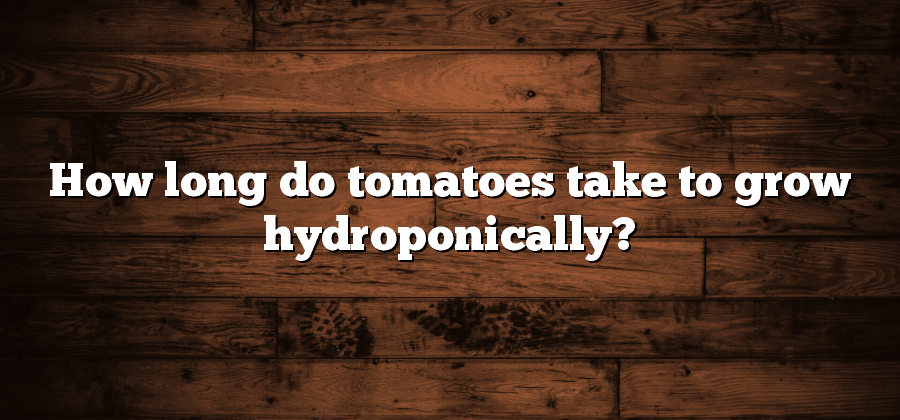Ideal Temperature for Hydroponic Tomato Growth
Hydroponic tomato cultivation offers a controlled environment that allows growers to optimize the growth conditions for their plants. One crucial factor to consider is the ideal temperature for tomato growth. Maintaining the right temperature range ensures healthy plant development, optimal nutrient uptake, and increased productivity.
Tomato plants thrive best in temperatures between 70°F (21°C) and 75°F (24°C) during the day. This promotes efficient photosynthesis, activating the plant’s metabolic processes and supporting robust growth. At night, the temperature can be slightly cooler, ideally around 65°F (18°C) to 70°F (21°C). Consistent temperature management throughout the day and night is vital as extreme fluctuations can stress the plants and negatively impact their overall health.
Optimal pH Levels for Hydroponic Tomato Cultivation
Maintaining the optimal pH levels is crucial for successful hydroponic tomato cultivation. The pH level refers to the acidity or alkalinity of the nutrient solution in which the plants grow. In order to ensure healthy growth and high yields, it is important to understand and monitor the ideal pH range for tomatoes in a hydroponic system.
Tomatoes thrive in slightly acidic conditions, with an optimal pH range between 5.8 and 6.3. This range provides the ideal conditions for nutrient uptake, as it allows the plants to absorb essential elements more efficiently. A pH level outside of this range can lead to nutrient deficiencies or toxicities, hindering the plant’s growth and development. By regularly measuring and adjusting the pH levels of the nutrient solution, hydroponic growers can provide the optimal environment for their tomato plants, maximizing their yield potential.
Selecting the Right Tomato Variety for Hydroponics
When it comes to hydroponic tomato cultivation, selecting the right variety is of utmost importance. Not all tomato varieties are well-suited for hydroponics, and choosing the wrong one can lead to subpar results. Therefore, it is essential to carefully consider certain factors before deciding on the tomato variety to grow in your hydroponic system.
First and foremost, you should consider the growth habit of the tomato variety. Some varieties are determinate, meaning they grow to a certain size and produce a concentrated crop, while others are indeterminate and continue to grow and produce fruits throughout the growing season. Determinate varieties are often more suitable for hydroponics, as they require less space and can be easily managed within a limited growing area. On the other hand, indeterminate varieties can be challenging to control in a hydroponic system due to their sprawling nature.
Additionally, it is crucial to consider the fruit characteristics of the tomato variety. You should select a variety that produces fruits of the desired size, shape, and color. Some varieties are renowned for their juicy flavor, while others are prized for their rich sweetness or tanginess. Understanding your target market and consumer preferences can help guide your choice of tomato variety for hydroponic cultivation.
Furthermore, the disease resistance of the tomato variety should not be overlooked. Hydroponic systems can sometimes create an environment conducive to the growth of certain diseases, such as root rot. Therefore, selecting a variety with high resistance to common diseases can save you from potential crop losses and the need for excessive pesticide use.
In conclusion, identifying the right tomato variety for hydroponics involves considering the growth habit, fruit characteristics, and disease resistance. Taking into account these factors will help ensure a successful and productive hydroponic tomato cultivation experience.
Nutrient Requirements for Hydroponic Tomato Plants
Hydroponic tomato plants require a balanced supply of nutrients in order to thrive and produce a bountiful harvest. These essential nutrients can be broken down into two categories: macronutrients and micronutrients. Macronutrients, such as nitrogen, phosphorous, and potassium, are needed in larger quantities to support overall plant growth and development. These nutrients play a crucial role in processes like photosynthesis, root formation, and fruit production. On the other hand, micronutrients, including iron, manganese, and zinc, are needed in smaller amounts but are equally important for various metabolic functions within the plant.
It is necessary to maintain the proper nutrient balance for hydroponic tomato plants to avoid deficiencies or excesses that can hinder growth and yield. Regular monitoring of nutrient levels is crucial to ensure that plants have access to the appropriate amounts of nutrients at each growth stage. Nutrient solutions can be prepared by following specific guidelines provided by experts in hydroponic farming. These guidelines outline the ideal concentration and ratio of nutrients necessary for optimal tomato plant growth. Additionally, it is important to consider the specific nutrient requirements of different tomato varieties, as certain cultivars may have varying needs.
Providing Sufficient Light to Promote Tomato Growth
To ensure optimal growth and development of hydroponic tomato plants, providing sufficient light is essential. Tomatoes are photoperiodic plants, meaning their growth is strongly influenced by light exposure. In hydroponic systems, where plants are grown in a controlled environment, it is crucial to replicate the natural light conditions to promote healthy and vigorous growth.
When it comes to light requirements for hydroponic tomatoes, intensity and duration are key factors to consider. Tomato plants require an average light intensity of 2500 to 3500 foot-candles (27,000 to 37,000 lux) for optimum growth. This can be achieved by using high-output fluorescent or LED grow lights, strategically positioned to ensure uniform coverage. It is important to provide a consistent light schedule, typically ranging from 14 to 16 hours of light per day. This mimics the natural day length and allows the plants to carry out essential photosynthesis processes efficiently. Additionally, using timers to automate the light cycle can ensure a consistent and reliable light source for optimal tomato growth.






